Artículos SCI
2017
2017
Propiedades mecánicas, modelización y caracterización de cerámicos avanzados
Ceramics of Ta-doping stabilized orthorhombic ZrO2 densified by spark plasma sintering and the effect of post-annealing in air
Sponchia, G; Moshtaghioun, BM; Benedetti, A; Riello, P; Gomez-Garcia, D; Dominguez-Rodriguez, A; Ortiz, ALScripta Materialia, 130 (2017) 128-132
Show abstract ▽
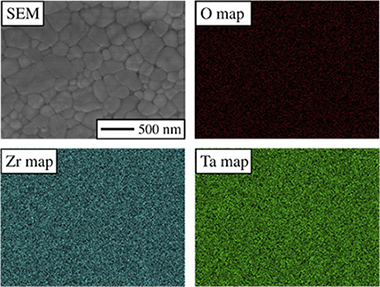
16 mol% Ta-doped ZrO2 powders were synthesized and densified by spark-plasma sintering (SPS) in vacuum, followed by post-SPS annealing in air, thus obtaining two ultrafine-grained ceramics consisting of Ta-doping stabilized orthorhombic ZrO2. The as-SPSed ceramic is black because it is actually a suboxide essentially with reduced cations and abundant oxygen vacancies, whereas the post-annealed ceramic is white because it is an oxide without vacancies and with only partially reduced cations. Both ceramics are relatively hard and brittle, but the as-SPSed ceramic was slightly more so, attributable to crystallographic and microstructural differences. Implications of interest for the ceramics community are discussed.
Marzo, 2017 | DOI: 10.1016/j.scriptamat.2016.11.021
Reactividad de Sólidos
Large-Scale Storage of Concentrated Solar Power from Industrial Waste
Perejon, Antonio; Valverde, Jose Manuel; Miranda-Pizarro, Juan; Sanchez-Jimenez, Pedro E.; Perez-Maqueda, Luis A.ACS Sustainable Chemistry & Engineering, 5 (2017) 2265-2272
Show abstract ▽
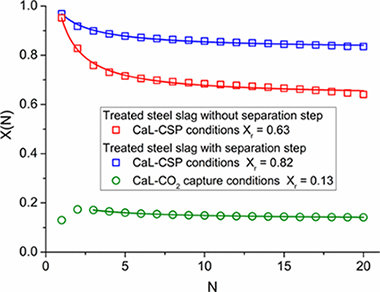
Deep penetration of renewable energies into the grid relies on the development of large-scale energy storage technologies using cheap, abundant, and nontoxic materials. Concentrated solar power (CSP) is particularly suitable to massively store thermal energy for dispatchable electricity generation. This is currently accomplished in a few demonstration plants by using molten salts albeit in a not competitive way yet. Process simulation studies indicate that thermochemical energy storage of CSP by means of the calcium looping (CaL) technology would reduce the cost of storage and increase the flexibility of energy supply provided that widely available and cheap CaO precursors with high and stable multicycle activity are used. In this work, we investigate the behavior of calcium rich steel slag at CaL conditions that would expectedly maximize the efficiency of CSP energy storage and power production. When treated with acetic acid, this nontoxic widely abundant waste yields a CaO rich solid with stable conversion near 0.8 over successive carbonation/calcination cycles at these CaL conditions
Marzo, 2017 | DOI: 10.1021/acssuschemeng.6b02576
Materiales Coloidales
Diverse Applications of Nanomedicine
Pelaz, Beatriz; Alexiou, Christoph; Alvarez -Puebla, Ramon A.; Alves, Frauke; Andrews, Anne M.; Ashraf, Sumaira; Balogh, Lajos P.; Ballerini, Laura; Bestetti, Alessandra; Brendel, Cornelia; Bosi, Susanna; Carril, Monica; Chan, Warren C. W.; Chen, ChunyingACS Nano, 11 (2017) 2312-2381
Show abstract ▽
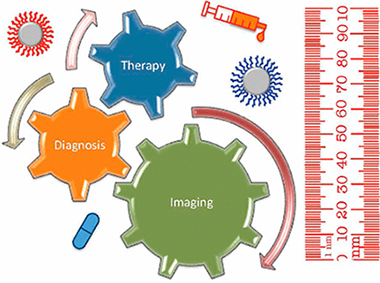
The design and use of materials in the nanoscale size range for addressing medical and health-related issues continues to receive increasing interest. Research in nanomedicine spans a multitude of areas, including drug delivery, vaccine development, antibacterial, diagnosis and imaging tools, wearable devices, implants, high-throughput screening platforms, etc. using biological, nonbiological, biomimetic, or hybrid materials. Many of these developments are starting to be translated into viable clinical products. Here, we provide an overview of recent developments in nanomedicine and highlight the current challenges and upcoming opportunities for the field and translation to the clinic.
Marzo, 2017 | DOI: 10.1021/acsnano.6b06040
Tribología y Protección de Superficies - Materiales Ópticos Multifuncionales
Strong Quantum Confinement and Fast Photoemission Activation in CH3NH3PbI3 Perovskite Nanocrystals Grown within Periodically Mesostructured Films
Miguel Anaya; Andrea Rubino; Teresa Cristina Rojas; Juan Francisco Galisteo-López; Mauricio Ernesto Calvo; Hernán MíguezAdvanced Optical Materials, 5 (2017) 1601087
Show abstract ▽
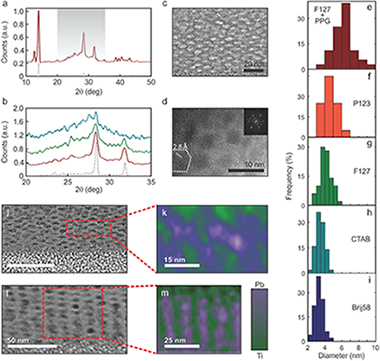
In this Communication, a synthetic route is demonstrated to obtain stabilized MAPbI3 nanocrystals embedded in thin metal oxide films that display well-defined and adjustable quantum confinement effects over a wide range of 0.34 eV. Mesostructured TiO2 and SiO2 films displaying an ordered 3D pore network are prepared by evaporation-induced self-assembly of a series of organic supramolecular templates in the presence of metal oxide precursors. The pores in the inorganic films obtained after thermal annealing are then used as nanoreactors to synthesize MAPbI3crystallites with narrow size distribution and average radius comprised between 1 and 4 nm, depending on the template of choice. Both the static and dynamic photoemission properties of the ensemble display features distinctive of the regime of strong quantum confinement. Photoemission maps demonstrate that the spectral and intensity properties of the luminescence extracted from the perovskite quantum dot loaded films are homogeneous over squared centimeters areas. At variance with their bulk counterparts, constant emission intensity is reached in time scales at least four orders of magnitude shorter.
Marzo, 2017 | DOI: 10.1002/adom.201601087
Tribología y Protección de Superficies
Solid lubricant behavior of MoS2 and WSe2-based nanocomposite coatings
Dominguez-Meister, S; Rojas, TC; Brizuela, M; Sanchez-Lopez, JCScience and Tecnology of Advances Materials, 18 (2017) 1
Show abstract ▽
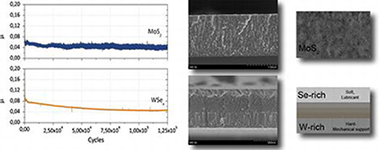
Tribological coatings made of MoS2 and WSe2 phases and their corresponding combinations with tungsten carbide (WC) were prepared by non-reactive magnetron sputtering of individual targets of similar composition. A comparative tribological analysis of these multiphase coatings was done in both ambient air (30-40% relative humidity, RH) and dry nitrogen (RH<7%) environments using the same tribometer and testing conditions. A nanostructural study using advanced transmission electron microscopy of the initial coatings and examination of the counterfaces after the friction test using different analytical tools helped to elucidate what governs the tribological behavior for each type of environment. This allowed conclusions to be made about the influence of the coating microstructure and composition on the tribological response. The best performance obtained with a WSe x film (specific wear rate of 2 x 10(-8) mm(3) N(-1)m(-1) and a friction coefficient of 0.03-0.05) was compared with that of the well-established MoS2 lubricant material.
Marzo, 2017 | DOI: 10.1080/14686996.2016.1275784
- ‹ anterior
- 199 of 420
- siguiente ›














